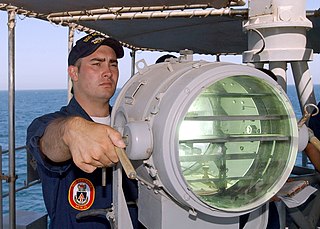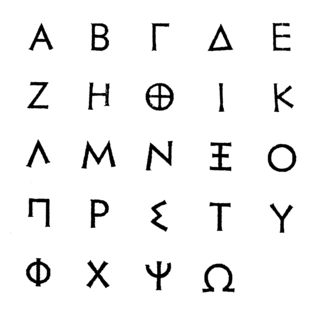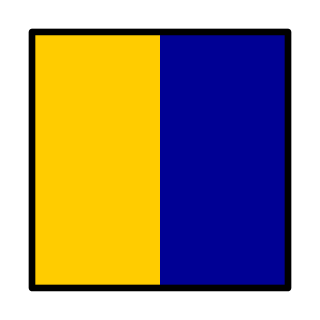
Digital data, in information theory and information systems, is information represented as a string of discrete symbols, each of which can take on one of only a finite number of values from some alphabet, such as letters or digits. An example is a text document, which consists of a string of alphanumeric characters. The most common form of digital data in modern information systems is binary data, which is represented by a string of binary digits (bits) each of which can have one of two values, either 0 or 1.
A signal is any variation of a medium that conveys information.
SOS is a Morse code distress signal, used internationally, that was originally established for maritime use. In formal notation SOS is written with an overscore line, to indicate that the Morse code equivalents for the individual letters of "SOS" are transmitted as an unbroken sequence of three dots / three dashes / three dots, with no spaces between the letters. In International Morse Code three dots form the letter "S" and three dashes make the letter "O", so "S O S" became a common way to remember the order of the dots and dashes.

The Allied military phonetic spelling alphabets prescribed the words that are used to represent each letter of the alphabet, when spelling other words out loud, letter-by-letter, and how the spelling words should be pronounced for use by the Allies of World War II. They are not a "phonetic alphabet" in the sense in which that term is used in phonetics, i.e. they are not a system for transcribing speech sounds.

Optical communication, also known as optical telecommunication, is communication at a distance using light to carry information. It can be performed visually or by using electronic devices. The earliest basic forms of optical communication date back several millennia, while the earliest electrical device created to do so was the photophone, invented in 1880.

Diver communications are the methods used by divers to communicate with each other or with surface members of the dive team. In professional diving, diver communication is usually between a single working diver and the diving supervisor at the surface control point. This is considered important both for managing the diving work, and as a safety measure for monitoring the condition of the diver. The traditional method of communication was by line signals, but this has been superseded by voice communication, and line signals are now used in emergencies when voice communications have failed. Surface supplied divers often carry a closed circuit video camera on the helmet which allows the surface team to see what the diver is doing and to be involved in inspection tasks. This can also be used to transmit hand signals to the surface if voice communications fails. Underwater slates may be used to write text messages which can be shown to other divers, and there are some dive computers which allow a limited number of pre-programmed text messages to be sent through-water to other divers or surface personnel with compatible equipment.

The Polybius square, also known as the Polybius checkerboard, is a device invented by the ancient Greeks Cleoxenus and Democleitus, and made famous by the historian and scholar Polybius. The device is used for fractionating plaintext characters so that they can be represented by a smaller set of symbols, which is useful for telegraphy, steganography, and cryptography. The device was originally used for fire signalling, allowing for the coded transmission of any message, not just a finite amount of predetermined options as was the convention before.

International maritime signal flags are various flags used to communicate with ships. The principal system of flags and associated codes is the International Code of Signals. Various navies have flag systems with additional flags and codes, and other flags are used in special uses, or have historical significance.

"England expects that every man will do his duty" was a signal sent by Vice-Admiral of the Royal Navy Horatio Nelson, 1st Viscount Nelson from his flagship HMS Victory as the Battle of Trafalgar was about to commence on 21 October 1805.
Flag signals can mean any of various methods of using flags or pennants to send signals. Flags may have individual significance as signals, or two or more flags may be manipulated so that their relative positions convey symbols. Flag signals allowed communication at a distance before the invention of radio and are still used especially in connection with ships.
OP-20-G or "Office of Chief Of Naval Operations (OPNAV), 20th Division of the Office of Naval Communications, G Section / Communications Security", was the U.S. Navy's signals intelligence and cryptanalysis group during World War II. Its mission was to intercept, decrypt, and analyze naval communications from Japanese, German, and Italian navies. In addition OP-20-G also copied diplomatic messages of many foreign governments. The majority of the section's effort was directed towards Japan and included breaking the early Japanese "Blue" book fleet code. This was made possible by intercept and High Frequency Direction Finder (HFDF) sites in the Pacific, Atlantic, and continental U.S., as well as a Japanese telegraphic code school for radio operators in Washington, D.C.

The International Code of Signals (ICS) is an international system of signals and codes for use by vessels to communicate important messages regarding safety of navigation and related matters. Signals can be sent by flaghoist, signal lamp ("blinker"), flag semaphore, radiotelegraphy, and radiotelephony. The International Code is the most recent evolution of a wide variety of maritime flag signalling systems.

Japanese input methods are used to input Japanese characters on a computer.

Procedural signs or prosigns are shorthand signals used in Morse code radio telegraphy procedure, for the purpose of simplifying and standardizing radio communication protocol. They are separate from Morse code abbreviations, which consist mainly of brevity codes that convey messages to other parties with greater speed and accuracy.
The combination of the Bravo and Zulu nautical signal flags, i.e., Bravo Zulu, also referred to as "BZ," is a naval signal, typically conveyed by flaghoist or voice radio, meaning "Well Done" with regard to actions, operations or performance. In addition to the British Royal Navy, it has also been used as part of vernacular slang within the U.S. Navy, NATO, and other Allied naval forces. It can be combined with the "negative" signal, spoken or written as NEGAT, to say "NEGAT Bravo Zulu" to convey "not well done" for a given action.

Flag semaphore is a semaphore system conveying information at a distance by means of visual signals with hand-held flags, rods, disks, paddles, or occasionally bare or gloved hands. Information is encoded by the position of the flags; it is read when the flag is in a fixed position. Semaphores were adopted and widely used in the maritime world in the 19th century. It is still used during underway replenishment at sea and is acceptable for emergency communication in daylight or using lighted wands instead of flags, at night.

Underwater acoustic communication is a technique of sending and receiving messages below water. There are several ways of employing such communication but the most common is by using hydrophones. Underwater communication is difficult due to factors such as multi-path propagation, time variations of the channel, small available bandwidth and strong signal attenuation, especially over long ranges. Compared to terrestrial communication, underwater communication has low data rates because it uses acoustic waves instead of electromagnetic waves.
Maritime flag signalling, generally flaghoist signalling, is the principal means other than radio by which ships communicate to each other or to shore. Virtually all signalling by non-naval vessels is now organized under the International Code of Signals, which specifies a standard set of flags and codes. Naval vessels generally use an extended set of flags and their own codes. This article will touch on the historical development of maritime flag signalling.
Naval flag signalling covers various forms of flag signalling, such as semaphore or flaghoist, used by various navies; distinguished from maritime flag signalling by merchant or other non-naval vessels or flags used for identification.

Semaphore is the use of an apparatus to create a visual signal transmitted over distance. A semaphore can be performed with devices including: fire, lights, flags, sunlight, and moving arms. Semaphores can be used for telegraphy when arranged in visually connected networks, or for traffic signalling such as in railway systems, or traffic lights in cities.












